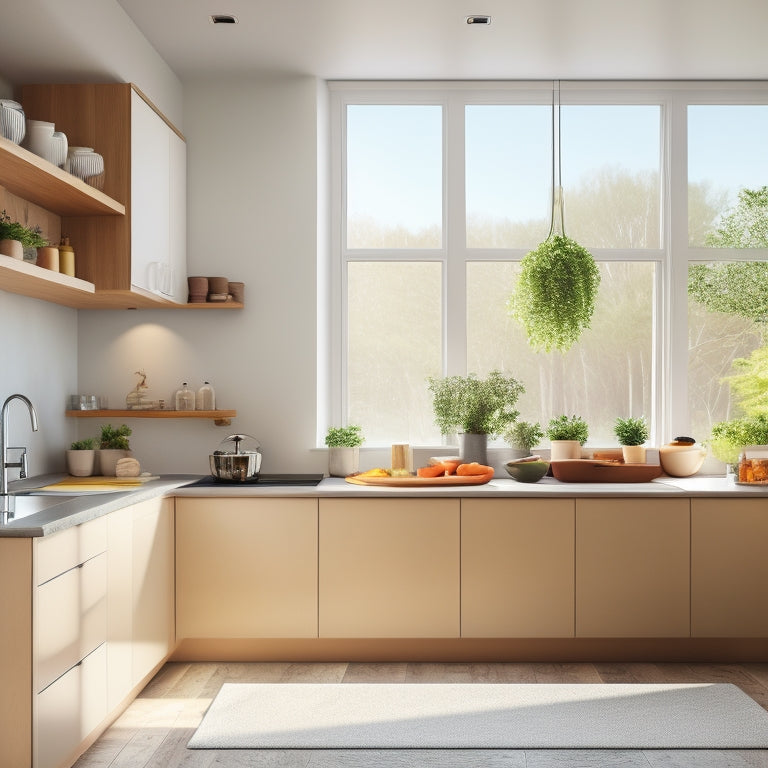
3 Essential Hacks for a Clutter-Free Kitchen
Share
To achieve a clutter-free kitchen, you'll want to start by identifying your trouble spots and prioritizing areas based on your daily habits and needs. Next, group similar items in your pantry for easy access and utilize baskets, bins, or dividers for organization. Finally, rearrange your kitchen layout to save time during meal prep by keeping frequently used items within arm's reach and optimizing your layout with a 'work triangle'. By implementing these three essential hacks, you'll be well on your way to a more efficient and organized kitchen – and there are even more tweaks you can make to take your kitchen to the next level.
Key Takeaways
• Identify and declutter trouble spots in the kitchen, prioritizing areas based on daily habits and needs for a more organized space.
• Utilize storage solutions like baskets, bins, and dividers to maximize vertical storage and keep similar items grouped together in the pantry.
• Streamline kitchen workflow by rearranging the layout for efficiency, keeping frequently used items within easy reach, and grouping similar tasks together.
• Optimize kitchen layout by designating specific areas for different tasks and placing items in easy-to-reach locations to enhance workflow.
• Simplify meal prep by planning ahead, reducing clutter, and making the most of available storage to create a clutter-free kitchen.
Decluttering Strategies for Success
To kick-start your kitchen decluttering journey, begin by identifying the areas that bother you the most, such as countertops cluttered with appliances or a pantry overflowing with expired food items. Take note of these trouble spots and prioritize them based on your daily habits and needs.
Next, tackle that disorganized pantry by grouping similar items together, such as grains, canned goods, and snacks. Assign a specific shelf or bin for each category, and make sure everything is easily accessible. Consider using baskets, bins, or dividers to keep items organized and visible. This won't only free up space but also simplify meal prep.
Simplifying meal prep is pivotal in maintaining a clutter-free kitchen. Start by meal planning, which will help you avoid last-minute takeouts and reduce food waste. Designate a specific area for meal prep, such as a countertop or island, and keep frequently used utensils and ingredients within easy reach.
Maximizing Storage in Tight Spaces
You can reveal hidden storage potential in even the smallest kitchens by reassessing the use of vertical space, corners, and often-wasted areas like the back of a cabinet door or the ceiling. By thinking creatively, you can turn these overlooked areas into functional storage solutions.
| Storage Solution | Description | Benefits |
|---|---|---|
| Vertical Storage | Install shelves, hooks, or pegboards on walls or ceilings to maximize vertical space | Saves floor space, keeps items organized, and easy to access |
| Drawer Organizers | Use dividers, inserts, or bins to organize contents of drawers | Reduces clutter, makes items easy to find, and saves time |
| Over-the-Door Storage | Hang baskets, hooks, or shelves on the back of a door to store items | Utilizes often-wasted space, keeps items organized, and adds functionality |
Streamlining Kitchen Workflow
By rearranging your kitchen layout and workflow, you can shave precious minutes off meal prep and cooking times. Start by identifying the tasks you perform most frequently, such as food prep, cooking, and cleanup. Then, organize your appliances and tools accordingly.
Place frequently used items in easy-to-reach locations, and group similar tasks together. For instance, designate a specific area for food prep, and keep all necessary utensils and appliances, like your stand mixer and food processor, within arm's reach.
Efficient meal prep relies on a well-organized kitchen. Consider a 'work triangle' layout, where your sink, stove, and refrigerator form the points of a triangle. This configuration minimizes walking distances and optimizes your workflow.
Organizing appliances, such as placing your coffee maker and toaster near the breakfast nook, also streamlines your morning routine. By optimizing your kitchen's layout and workflow, you'll be able to prep, cook, and serve meals quickly and efficiently, giving you more time to focus on what matters – enjoying your meals and spending time with loved ones.
Frequently Asked Questions
How Do I Maintain My Clutter-Free Kitchen Over Time?
"Did you know 71% of people feel overwhelmed by clutter? You'll avoid this by implementing organization systems and daily routines, like tidying up after meals and scheduling weekly deep cleans, to maintain your clutter-free kitchen over time."
Can a Clutter-Free Kitchen Really Improve My Mental Health?
You'll be amazed at how a clutter-free kitchen can boost your mental health! By incorporating mindfulness benefits and organization techniques, you'll reduce emotional stress and anxiety, making the decluttering process a therapeutic experience.
Are There Any Eco-Friendly Decluttering Methods I Should Know?
You're looking for eco-friendly decluttering methods, and you should know about sustainable organization and green decluttering techniques, like repurposing old items, donating gently-used goods, and using eco-friendly cleaning products to minimize waste and reduce your carbon footprint.
How Do I Declutter My Kitchen on a Tight Budget?
'Sparkle up your space with savvy solutions! You're decluttering on a dime, so immerse yourself in DIY storage projects, and explore donation options to refresh your kitchen without breaking the bank.'
Can I Still Have Decorative Items in a Clutter-Free Kitchen?
You can absolutely have decorative items in a clutter-free kitchen, as long as you strike a balance between functional decor and organization, embracing a minimalist design that prioritizes practicality over aesthetics.
Related Posts
-

What's the Best Way to Store Recipes Online?
You're ready to ditch the recipe chaos and streamline your collection with a digital storage solution. The best way t...
